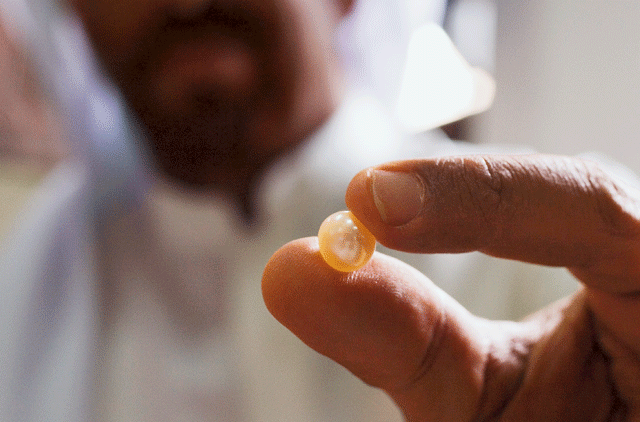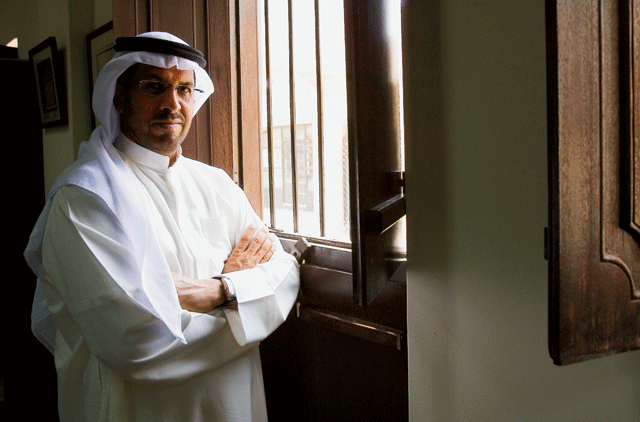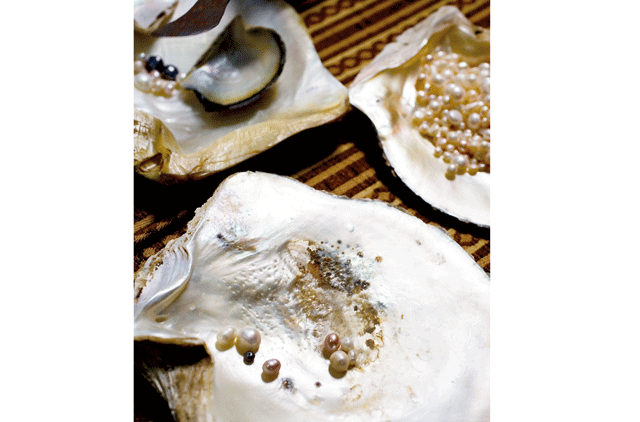
As they push the dhow into the sea, their sun-baked faces wear a smile. Hearts race with excitement as eager feet exult in the contact with the quivering of the ocean. They tug at the wooden vessel, jump into it and begin hauling the ropes. The white sail rises majestically and begins to billow. A salty breeze caresses the sailcloth, the lines stretch taut as the dhow begins its graceful glide over the shimmering waters and the boatmen slowly begin to singa rhythmic song that carries over the waters as a lilting chorus. It is the song of happiness, as once again, they are reunited with the ocean. Skilfully, they journey to the heart of the ocean and anchor as their leader commands.
A select few rise from their place, take in a deep breath of the crisp morning air and in a clean flash, plunge into the opaque blue below them. In the deep shifting strands of light, amidst the ocean's unparalleled bounty, the divers look for a particular kind of treasure and as and when they find it, they pluck it and toss it into their bag. It is a swim past colourful corals and beautiful fish.
Back on the boat they gather to reveal the harvest each has reaped - oysters that contain one of nature's most wondrous creations. Of course some shells disappoint as they contain lumps of sea sand, but others reveal the opalescent beauties - pearls. For a deepsea diver, the cache of pearls he succeeds in getting is exciting, but what is life-affirming is the actual act of pearl diving. An act that defines his relationship with the sea, his respect for it and his humility in learning the lessons it teaches before it parts with its treasures.
Learning to plumb the depths of the ocean to look for the wealth it conceals is not just about taking the plunge. It is a timeless learning curve that involves knowing how nature works - the wind, the tides, the sun and the undercurrents - all of which have a formidable effect on a man's fate once he decides to get his feet wet. There is no one point in this learning period where a pearl diver can say he knows it all. Every day he will be forced to acknowledge anew the mighty tempestuousness of nature or its benign hospitality. And in this constant respectful deference to its ultimate power lie the milestones of his personal success.
Pearl diving is the immovable heritage of the UAE. A way of life in the not-so-distant past that gavea unique identity to this nation.
With modernisation, it was inevitable that this tradition moved away from the front line. In an effort to keep its presence from moving too far back from collective memory, the Emirates Diving Association (EDA), the regulatory body for the diving industry in the UAE, in association with the Knowledge and Human Development Authority (KHDA), has launched three heritage books on the subject. They were compiled by Juma Khalifa Ahmad Bin Thalith Al Humairi, who is one of the founding members of the EDA.
The books shed light on various seafaring traditions from the past. Compiled after extensive research, they are the only books available on their respective subjects that have such detailed content with pictorial glossaries of local terms.
The man behind the books
"As we progressed, we left behind those days of glory and toil," says Al Humairi. "The days of deepsea expeditions are now behind us. We seldom live such moments of triumph and skill. They are a thing of the past but the pull of these memories is still felt by us. The stories they have lived are real; their efforts at sea gave strength to our economy, it moulded our community and the way we lived. These tales are passed down by word of mouth from one generation to the next… The youth of today are living in a fast-paced era. Influenced by different factors, our children are slowly drifting away from their roots. Due to the demands of their profession, education or social network they spend less time at home with their elders. My books are aimed at providing the link between the generation of today and their heritage. It will keep the knowledge of our past alive," adds Al Humairi.
"As a young boy, I would accompany my father on expeditions to the sea. By the time I was 19,I was a skilled diver with a sound knowledge of the blue waters. To further my affair with the ocean, I learnt underwater photography and videography. I enjoyed the company of wise old men and they appreciated that someone with young blood was keen to learn more from them. This was six years ago. At the time I would just take down notes when these elders spoke. Later I realised the value of what I was gathering from them and began sorting the information into relevant categories. Thus the books were born," he recalls. He hopes to ignite a passion for exploring the sea in the generation of today and those to come.
"The ocean is a treasure by itself - whether it's food from the fish, riches in the form of the pearls or economic growth from the oil, we have received it all from the blue vastness.
"We must never forget or neglect to learn from the lessons that it has taught us. We owe our identity toits vastness.
"In the deep of the ocean, I see a reflection of my ancestors - the foundation of an industry that my country was identified with. As an Emirati, I understand the bond that my forefathers shared with the waves but the youth today don't hold much respect for the sea. They are unaware of many diving and seafaring terms. Slowly the heritage and knowledgeare fading away."
Al Muhairi felt the imperative need to infuse new life into a dying tradition, so he took up the heritage book project. To compile the books, Juma collated information from his own experiences and logbooks. For definite facts and terms, he spoke to elderly men who spent most of their lives at sea. "We would spend long hours discussing the finer details of the books. The entire journey of creating them has been enriching," he adds. "Apart from collecting information for the book I would need to find my guides too. Having retired from their seafaring jobs and facing the ravages of old age, these men would frequent popular coffee shops and traditional souqs, whereI would meet them. They would often be sitting together, mute spectators to the world around them, reminiscing about old times. I would ask them if I could join in. I would speak to them using the dialect and terms of their days. That would add a sparkle to their eyes and they would welcome me as their own. It's amazing how much connectivity remains in old ties and times. They love to speak to youngsters but they open up only if they see that you value what they have to say. It is a very tender twine that binds their hearts."
To keep the bond of this tradition alive, Al Muhairi manages the Heritage Department at EDA, which conducts marine environmental campaigns and educates the public on the latest news related to the industry through its quarterly magazine and its range of activities.
Apart from writing books, he gives lectures on diving and is invited by schools and universities to educate the younger generation on the history of pearl diving.
EDA's chairman Faraj Butti Al Muhairbi, who used to be a pearl diver himself, organises seasonal fortnight-long pearl dive trips and invites young UAE divers to join him on these trips which replicate the experiences of divers years ago.
Divers refer to maps of the diving site and are given a briefing priorto the dive.
Lessons from the past
The experiences at sea were tough but different people see things in different ways, says Al Muhairi. "While some don't like to go down memory lane, others joke about it and enjoy sharing that which they learnt."
The annual diving expeditions were planned in keeping with the vagaries of the season.
Sailors were expected to return to shore within four months and ten days of setting sail. This time span coincides with the duration that Islam marks for a married woman to stay in waiting for her husband who has gone to battle or trade.
"The society was mainly divided into three categories: men, women and dependents [children and the elderly]. When the men went out to sea, the women and dependents lived in the oasis cities like Kasab andAl Ain. Here, food was readily available for them. They returned to their homes just in time to welcome the men of the house from their seafaring expeditions."
These men often tell tales about paranormal sightings and encounters, of spotting mermaids, sea urchins and arcane activities happening on and off deck. It cannot be clearly concluded if these were just hallucinations due to fatigue, or real.
At sea, it was not uncommon to see fleets of ships being sucked into storms and tornadoes. A sailor would have to have a firm heart to be able to face such calamities.
If a sailor died at sea, his body was prepared for its last rituals just as they would have done had he been on land - only they would tie some weight to the body and throw it overboard.
"On the vessel there was always an organised system of work. Chores were distributed in a set pattern so that all individuals shared responsibilities. Each man was answerable for his tasks, failing which he would be reprimanded for his negligence.
"Young men were judged by their conduct at sea. The more vigilant and productive they were, the more eligible they were considered as bachelors. Their ability to workhard proved to the elders that they would be capable providers for their future families… In the depths below, no hierarchy was followed. Naturehas its own set of rules and survivalis only for those who are the fittest. Knowing not to tamper with thelaws of nature is the best thing one can ever do."
Social partnership
In recent times, emphasis has been placed on developing a sense of national identity among the youth, and several government organisations have sought to create this awareness through organising educational seminars, exhibitions, workshops and other events. With a pivotal responsibility in the field of education, the Knowledge and Human Development Authority (KHDA) was roped in for the heritage books project of the EDA. Dr Abdullah Al Karam, Chairman of the Board of Directors and Director-General at KHDA, says, "Education is our area of expertise. We aim to better the lessons available to us - whether it is through evaluating teaching methods or developing content for learning. The heritage books are rich with knowledge and the best role we could play in the process was that of documentation and preservation of this knowledge. When one learns from our past, we are better prepared for the future and have a fruitful present too."
The KHDA is committed to working with its partners in order to spread a culture of heritage awareness and preservation among the young generation, he adds, which will have a tremendous impact on their environmental activities and behaviour, leading to a better future.
"The books are a perfect example of a social partnership between the KHDA and public and private institutions. I call on all educational authorities in the region to take full advantage of these books that highlight the relationship between the people of the UAE and the sea. It is up to the respective administrations of the schools to make sure this happens, and to further develop environmental and heritage concepts in students through extracurricular activities that aid in their mental, social and behavioural development.
"I strongly believe that certain things are a vehicle to take forward things from our past like the food we eat, our dress sense, our values of trade and our culture of hospitality and hard work," he continues. "In the olden days, the pearling industry provided the only real income for the people. Land was too barren to allow any farming and people were generally too concerned with finding water, food and other provisions to consider trying to make money.
"The barter system was their way of trading. Families found it convenient to leave the nomadic desert life to settle on the coast where they had access to water and food in the form of fish.
"Soon they came upon pearls and kept them until there was an opportunity to barter them. Togather enough oysters to makea living, however, required a huge communal effort, and that is what brought the people together -a desire to earn and to live a secure life," explains Dr Al Karam, whose grandfather traded pearls, and whose father was a diver. He has heard many stories from his elders and values the moral of each story.
Planning and management
"Business was smooth and efficient. Times were tough but the people were happy," adds Dr Al Karam. "It was the simplicity in day-to-day life which gave it the fullness of achievement and growth. The pearl season was from May to September. This was the time the villagers lived for. Their resources were their people and they used what they had to plan expeditions that were accurate and worthwhile. After gathering from the sea, the men would trade the pearls for spices, food, cloth and other necessities from the tradesmen of India and other countries. Any shortcoming during the pearl diving expedition meant less harvest, less harvest meant poor trade and poor trade equalled no goods for the villagers and children.
"Managing a ship from dock and back is the way you should run an organisation," he continues. "Work segregation and multitasking was done to ensure a smooth sail through the voyage. Journeys were planned such that the fleet did not go too far, too soon. They believed in the ‘slow and steady' attitude. Value was given to the final product and care was taken to ensure that the route taken was thoughtful. Things were done in a particular way for a particular reason.
"We must observe and learn from our past," he says. "It is crucial for our future. While development has brought with it many conveniences, we must understand that our forefathers led a life that was planned for success." It was a time when little things were taken seriously because they were significant. When you understand the true meaning of a life the way it was led then, there will be, he says, no doubt in anyone's mind about "the strength of our blood and the lessons that have been seeded in our history."
The stories of the past are best acknowledged by taking them into the future.
"You are," says Dr Al Karam, "nothing without your past."
- Ruqya Khan is a Sharjah-based freelance writer
THE BOOKS
"The heritage books project is important to us because it relates the present with the past and takes itselfto the future too. Pearl diving was an important part of the economy ofthe Arabian Gulf before the current oil boom. Local pearl divers [took] great risks to collect oysters from the ocean floor, but the rewards were worth it. The income received from the pearl industry helped support many families. These books shed light on a very interesting and important period in our history," says Reema Al Abbas (above right), projects manager at the EDA.
"The books are an expression of the strong bond between Emiratis and the sea," she continues. "The sea has given us a lot over the years; it shared its secrets with us, it gave us knowledge, and helped us through the struggles of life. It gave us pearls as well, and offered us routes for trade and travel.
"We should really put these books to good use, because these are comprehensive works that document marine historyin the UAE.
"The knowledge from the ocean is vast; it's God's big bounty of blessings. Putting such in-depth books together is demanding on time and resources but we are privileged to be taking this work forward for the youth.
"Students can utilise the information for various studies - biology, history, mathematics and more. The books are illustrated with pictures. I feel that soon they will draw attention of schools in other Middle Eastern countries too; after all, we share the same heritage and culture."
The three books are:
1. Diving and pearls ofthe UAE: History of pearl diving in the UAE
Launched in 2007, this 140-page publicationwas the first of its kind in the region. Offering glimpses of the historical significance of pearl diving and the maritime legacyof the Gulf, the book includes a compilation of interviews with old pearl divers and UAE nationals on their experiences of diving in the UAE.
2. Marine and Heritage Diving Encyclopaedia: Pictorial dictionary of local words and terms used in the pearl-diving industry
Launched in 2009, this Diving Encyclopaedia contains 250 pictures and data on 1,055 species. Close to 90 per cent of the information is on traditional diving techniques and the language and phrases used by divers and fishermen of bygone days.
Plans are currently under way to use the encyclopaedia as supportive educational material within the national curriculum.
3. Men of Pearl Diving in the UAE: Names and history of the UAE people who worked in the pearl-diving industry
Launched on the 38th National Day of the UAE (2009), this book tells the story of pearl diving in the UAE, and lists the brave captains who steered the industry.to success.













